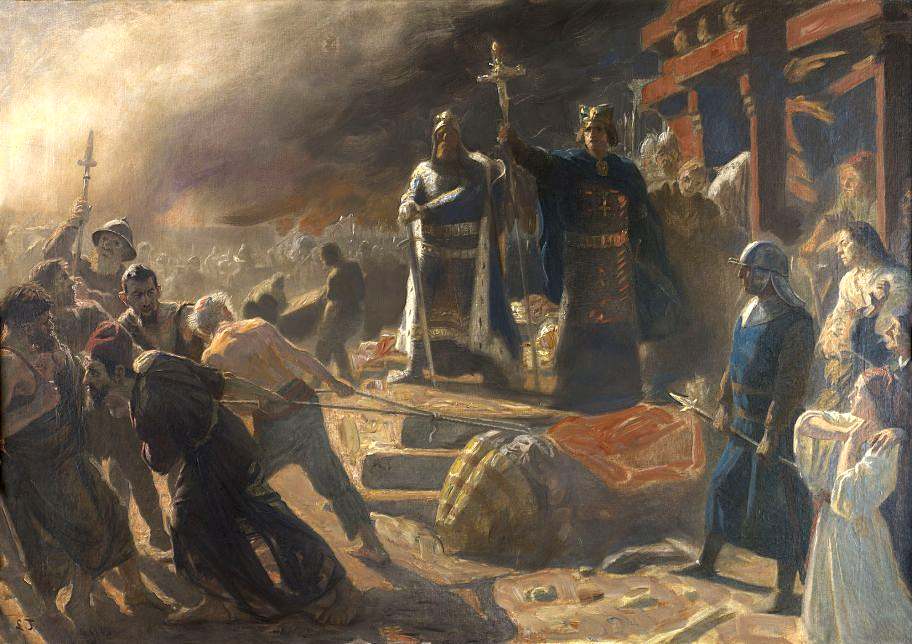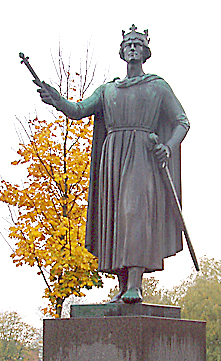1. Early Life and Background
Valdemar I's early life was shaped by political turmoil and the influence of powerful Danish noble families, which provided the foundation for his later rise to kingship.
1.1. Birth and Family
Valdemar was born on 14 January 1131, shortly after the murder of his father, Canute Lavard, the Duke of Schleswig. Canute Lavard was the chivalrous and popular eldest son of King Eric I. Valdemar's mother was Ingeborg of Kiev, daughter of Grand Prince Mstislav I of Kiev and Christina Ingesdotter of Sweden. Ingeborg named her son Valdemar after her grandfather, Grand Prince Vladimir Monomakh of Kiev. His father, Canute Lavard, was murdered by King Magnus I of Sweden, a rival claimant to the Danish throne, just days before Valdemar's birth. Valdemar belonged to the House of Estridsen.
1.2. Upbringing and Education
Valdemar was raised at Ringsted in the court of the Danish nobleman Asser Rig of Fjenneslev (1080-1151). Asser Rig was a prominent member of the Hvide noble family and had been raised alongside Valdemar's father, Canute Lavard. Valdemar grew up with Asser Rig's sons, Absalon (1128-1201) and Esbern Snare (1127-1204). Absalon would later become a highly influential archbishop and Valdemar's chief advisor, accompanying him in battles. Esbern Snare served as a royal chancellor and crusader. The three maintained a close relationship and formed a powerful alliance that would prove crucial during Valdemar's reign.
2. Struggle for the Throne
The period following the abdication of Eric III plunged Denmark into a decade-long civil war, from which Valdemar I eventually emerged as the sole monarch.
2.1. Civil War and Succession Disputes
In 1146, when Valdemar was fifteen years old, King Eric III abdicated the Danish throne, triggering a protracted civil war. Valdemar emerged as a contender for the throne, alongside two other powerful claimants: Sweyn III Grathe, son of King Eric II, and Canute V, son of King Magnus I of Sweden. Both Sweyn and Canute declared themselves King of Denmark in 1146. This dynastic struggle destabilized the kingdom for over ten years. In 1154, Valdemar allied with Canute V, and they were recognized as co-kings. By July 1157, a temporary compromise was reached, where the three rivals agreed to divide the country among themselves as co-regents, forming shifting alliances.
2.2. Consolidation of Power
The fragile peace was shattered in August 1157 at the Bloodfeast of Roskilde. During a banquet intended for reconciliation, King Sweyn III attempted to assassinate his rivals. Canute V was killed, but Valdemar I managed to escape the ambush. Valdemar fled to Jutland, where he gathered his forces. On 23 October 1157, Valdemar's forces decisively defeated Sweyn III's army at the Battle of Grathe Heath (Slaget på Grathe HedeDanish). Sweyn III was killed during his flight from the battlefield, reportedly by a group of peasants who encountered him. With the elimination of all his rival pretenders, Valdemar I became the sole King of Denmark, bringing an end to the decade-long civil war.
3. Reign and Major Activities
As sole monarch, Valdemar I embarked on a period of significant national reconstruction, military expansion, and administrative reform, cementing Denmark's position as a regional power.
3.1. National Reconstruction and Defense
Upon becoming sole king, Valdemar I appointed his childhood friend, Absalon, as his chief advisor in 1158, after Absalon was elected Bishop of Roskilde. Together, they undertook the ambitious task of reorganizing and rebuilding Denmark, which had been devastated by years of civil war. Valdemar focused on strengthening the kingdom's defenses. He reinforced the Dannevirke fortifications in the south, a crucial defensive barrier. He also oversaw the construction of key castles to enhance security and royal authority. Among these was Sønderborg Castle, built as a fortified stronghold on an islet in the Als Strait, which was later connected to Als Island. In 1175, King Valdemar further expanded his defensive network by building Vordingborg Castle, which served as both a protective fortress and a strategic base for launching military expeditions against the German coast.
3.2. Military Campaigns and Expansion
Valdemar I's reign was marked by vigorous military campaigns, primarily against the Wends, a Slavic people who frequently raided the Danish coasts from their strongholds in Pomerania and the island of Rügen in the Baltic Sea. The Wends significantly outnumbered the Danes, posing a substantial threat to Danish control of the Baltic. At Absalon's instigation, Valdemar declared war on the Wends. He adapted and reinvented old Viking raiding tactics, optimizing them for heavy cavalry, a strategy that involved amphibious assaults. This method was further refined by his successor, Canute VI.
Danish forces began systematically raiding the Wendish coasts, culminating in the conquest of Rügen in 1168. Rügen then served as a new base for further Danish incursions into Wendish territory. This expansion extended Danish influence into both Pomerania and the Obotrite confederacy, which were routinely subjected to Danish raids. The Wendish capital of Arkona was captured in 1168, leading to the Wends' conversion to Christianity and their submission to Danish authority. Around 1170, a smaller contingent of the Danish fleet, led by Valdemar and Absalon, ventured past the mouth of the Oder River. They were ambushed by a Wendish army and fleet under Casimir I, Duke of Pomerania, at the Battle at Julin Bridge (modern-day Wolin), who hoped to end Danish raiding. However, the Danes outmaneuvered the Wends, crushing their forces, largely due to the presence of cavalry on the Danish ships.

3.3. Domestic Policy and Governance
Valdemar I also focused on internal affairs to ensure the stability and prosperity of his kingdom. In 1180, significant unrest erupted in Scania, one of Denmark's wealthiest provinces. The local population demanded that Valdemar replace the "foreign" governors from Jutland with nobility from the traditional Skåneland provinces. They also staunchly refused to pay church tithes. When Valdemar initially rejected their demands, the Scanian people rose in revolt, declaring their refusal to pay either royal taxes or church tithes. The rebellion grew so large that Valdemar had to call upon levies not only from his own territories but also from Blekinge to suppress it.
The royal army clashed with the rebels at the Battle of Dysiaa, where Valdemar decisively crushed the uprising. Following the defeat, the Scanian peasants resumed paying taxes. However, they continued to refuse the payment of tithes. In response, Valdemar I, demonstrating a pragmatic approach to governance, instructed them to instead provide generous gifts and donations to the church. While they would not pay tithes directly, they would still contribute financially. The only major concession Valdemar made was to replace the Jutlandic governors with Scanian nobles, a policy that recognized local traditions and helped maintain peace within the province. This principle of local governance-where a Jute ruled in Jutland and a Rugian in Rügen-was subsequently applied throughout the Danish realm, greatly contributing to internal stability and later influencing the administration of the extended kingdom under the Kalmar Union.
4. Personal Life
Valdemar I's personal life, particularly his marriage and the birth of his many children, played a crucial role in securing the dynastic future of Denmark.
4.1. Marriage and Children
Valdemar I married Sophia of Minsk (1141-1198) in Viborg on 23 October 1157. Sophia was the daughter of Richeza of Poland, the dowager queen of Sweden, from her marriage to Prince Volodar of Minsk. She was also the half-sister of Valdemar's former co-king and rival, Canute V of Denmark.
Valdemar and Sophia had numerous children who would play significant roles in Danish and European history:
- Sophia (1159-1208), who married Siegfried III, Count of Weimar-Orlamünde.
- Canute VI (1163-1202), who succeeded his father as King of Denmark.
- Maria (born 1165), who became a nun at Roskilde in 1188.
- Margaret (1167-1205), who also became a nun at Roskilde in 1188.
- Valdemar II (1170-1241), known as "Valdemar the Victorious," who also became King of Denmark.
- Ingeborg (1174-1237), who married King Philip II of France and became Queen of France.
- Helena (1176 - 1233), who married William, Duke of Brunswick-Lüneburg.
- Rikissa (1178 - 1220), who married King Eric X of Sweden and became Queen of Sweden.
- Walburgis (died 1177), who married Bogusław I, Duke of Pomerania.
After Valdemar's death, Sophia married Landgrave Louis III of Thuringia in 1184.
Valdemar also had an illegitimate son, Christopher of Denmark (1150-1173), with a mistress named Freeli Tove. Christopher served as Duke of Jutland (dux Iuciae) from 1170 to 1173. Some historical accounts, though unconfirmed, describe Queen Sophia as a beautiful but cruel woman who allegedly ordered the murder of Freeli Tove and injured Valdemar's sister, Kirsten.
5. Death
Valdemar I died on 12 May 1182, at the age of 51, at Vordingborg Castle. He was succeeded by his eldest legitimate son, Canute VI.
6. Legacy and Assessment
Valdemar I's reign is widely regarded as a pivotal period in Danish history, laying the groundwork for the kingdom's emergence as a dominant power in Northern Europe.
6.1. Historical Significance
Valdemar I is historically known as "Valdemar the Great" due to his foundational role in establishing Denmark as a major medieval power. His achievements in state-building and consolidation were immense. He successfully ended a decade of civil war, reunifying the kingdom and restoring stability. His strategic military campaigns, particularly against the Wends, secured Denmark's borders and expanded its influence across the Baltic Sea, transforming a defensive struggle into a period of territorial expansion. The reconstruction of infrastructure, including fortifications and castles, further solidified royal authority and national security. His reign is seen as the beginning of Denmark's medieval golden age, which reached its peak under his son, Valdemar II.

6.2. Influence
The lasting impact of Valdemar I's reign and policies was profound, particularly on his successor, Valdemar II. The strong, centralized kingdom and the expanded territorial base he established provided Valdemar II with the foundation needed to further extend Danish political and territorial influence, leading to the zenith of the Danish Empire in the 13th century. Valdemar I's administrative reforms, including the pragmatic approach to provincial governance demonstrated during the Scania revolt, helped to maintain internal peace and laid precedents for future governance, even influencing the structure of the later Kalmar Union. His close collaboration with figures like Absalon also set a precedent for strong royal-ecclesiastical partnerships that benefited the kingdom's development.